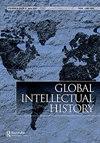Women’s International Thought: A New History
IF 0.4
Q2 HISTORY
引用次数: 1
Abstract
According to international-law scholar Thomas Baty (1869–1954), the state is an idea (Baty, 1930). So is the corporation (Baty, 1920). Presumably then, the conceptual (and physical) contours of states, federations, corporations and empires are constantly redrawn through ongoing reflection, rhetoric and civic engagement. Baty’s mere question ‘Do ideas have rights?’ points to the perplexity of designing states and empires through intellectual reflection (Baty, 1920). Conceiving of states and empires in this contingent and instrumental way appears both liberating and frightening. If nothing is set in stone, an ongoing, more inclusive and democratic process of redefining various forms of association is made possible. And if the state is an idea, a whole range of expressions can be subsumed under thought about the state, including revolutionary and secession acts, pamphleteering, advocacy, journalism, dinner-table conversations, diary entries and so on. In a sense, we all inevitably have thoughts about the nature of states, corporations and empires, and may express them in a whole range of ways and fora. But not everyone’s thoughts count equally in the ultimate design and operation of states and empires. States are both human creations and the production of a few minds selected through arbitrary, discriminatory and often violent processes. Oftentimes, the selection process of whose views ‘count’ is made through a loose but consequential distinction between thoughts and thought. The former is supposed to identify a range of individual ideas, possibly unarticulated and contradictory, whereas the latter suggests a more structured and consistent way of thinking about these concepts (p. 306). This loose distinction between thoughts and thought often ends up being coupled with distinctions between genres and fora, which are thought more conducive to one or the other. Dinner-table conversations and pamphleteering are often understood as ways of expressing different disorganised thoughts, whereas academic writing and government memoranda are conducive to ‘serious’ thought on the matter (pp. 133–135). One is labelled trivial and therefore easily ignored, and the other one is celebrated and supported. All of these distinctions are familiar to feminists who have long fought against labelling women as emotional, rather than rational, or as prone to distortions of thought and memory when giving testimony in court, or as unworthy to access institutions where the only recognised form of thought gains political salience. This feminist insight has already contributed to a process of discovering unknown or forgotten female figures in various areas of the humanities. However, in international law and international relations (IR), it led primarily to the production of feminist schools of thought, rather than feminist history. Recently, both fields are beginning to ask where female actors might be found in the history of their fields. Immi Tallgren’s forthcoming edited collection Portraits of Women in International Law (2021) contains portraits of several dozen women in the history of international law. Patricia Owens and Katharina Rietzler’s Women’s International Thought: A New History catalogues fifteen women’s incredibly rich engagement with international matters, bringing questions of race, domination and colonial subjugation to the fore in a powerful and inspiring way. This volume represents a wonderful invitation to rethink the politics of the distinctions between thoughts and thought, and妇女国际思想:一部新的历史
根据国际法学者Thomas Baty(1869–1954)的观点,国家是一种理念(Baty,1930)。公司也是如此(巴蒂,1920)。据推测,通过持续的反思、言论和公民参与,国家、联邦、公司和帝国的概念(和物理)轮廓不断被重新绘制。巴蒂的问题“思想有权利吗?”指出了通过智力反思来设计国家和帝国的困惑(Baty,1920)。以这种偶然性和工具性的方式来构想国家和帝国,似乎既解放又可怕。如果没有什么是板上钉钉的,那么重新定义各种形式的结社的持续、更具包容性和民主的进程就成为可能。如果国家是一个概念,那么对国家的思考可以包含一系列的表达,包括革命和分裂行为、小册子、宣传、新闻、餐桌对话、日记等等。从某种意义上说,我们都不可避免地对国家、公司和帝国的性质有想法,并可能以各种方式和论坛表达。但并不是每个人的思想在国家和帝国的最终设计和运作中都同等重要。国家既是人类的创造,也是通过武断、歧视和往往是暴力的过程选出的少数人的思想的产物。通常,选择谁的观点“重要”的过程是通过思想和思想之间松散但重要的区别来进行的。前者被认为是确定了一系列个人的想法,可能是不明确和矛盾的,而后者则提出了一种更结构化和一致的思考这些概念的方式(第306页)。思想和思想之间的这种松散区别往往与流派和论坛之间的区别结合在一起,这些流派和论坛被认为更有利于其中之一。餐桌谈话和小册子通常被理解为表达不同无序思想的方式,而学术写作和政府备忘录有助于对此事进行“严肃”思考(第133-135页)。一个被贴上琐碎的标签,因此很容易被忽视,另一个则受到赞扬和支持。所有这些区别对于女权主义者来说都很熟悉,她们长期以来一直反对给女性贴上情绪化而非理性的标签,或者在法庭上作证时容易扭曲思想和记忆,或者不值得进入唯一公认的思想形式获得政治显著性的机构。这种女权主义的见解已经为发现人文学科各个领域中不为人知或被遗忘的女性形象做出了贡献。然而,在国际法和国际关系中,它主要导致了女权主义学派的产生,而不是女权主义历史。最近,这两个领域都开始问,在各自领域的历史上,女性演员可能在哪里找到。Immi Tallgren即将出版的编辑集《国际法中的女性肖像》(2021)收录了国际法史上几十位女性的肖像。帕特里夏·欧文斯(Patricia Owens)和凯瑟琳·里茨勒(Katharina Rietzler。这本书很好地邀请我们重新思考思想和思想之间区别的政治问题
本文章由计算机程序翻译,如有差异,请以英文原文为准。
求助全文
约1分钟内获得全文
求助全文

 求助内容:
求助内容: 应助结果提醒方式:
应助结果提醒方式:


